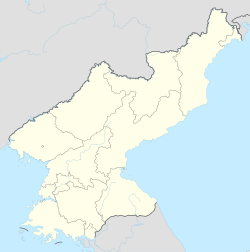History
By the early 1980s, North Korea needed a flight-test facility for its program to reverse-engineer and produce copies of the Scud-B which it acquired from the Soviet Union in the late 60s. Previously, North Korea used a facility at Hwajin-ri, Pyongwon-kun, South Pyongan Province to test for anti-ship missiles and probably FROGs, surface-to-air missiles (SAMs) and other rockets. However, Hawjin-ri had insufficient range for the Hwasong-5, which would enter Chinese territorial waters during a test. The construction of the facility continued off and on throughout the 1980s and 1990s. Construction was made by the 117th Regiment under the Air Force Construction Bureau of the Ministry of People's Armed Forces. [5] Construction of the launch pad was completed in 1985. During the early stage of construction, the site had an extremely rudimentary infrastructure, such as a few roads, a command bunker, a radar facility, and modest storage and support facilities.
However, by the early 1990s, the Tonghae site was reportedly expanded from 2 km to 9 km and the following infrastructure was added: a missile assembly facility, a fuel storage facility, a guidance and range control center, and tracking facilities.
The first launch from the site is reported to have occurred on 1 April 1984. [2] Since that year, military rockets of the types Hwasong, Rodong and Taepodong-1 were launched from Musudan-ri. In 1998, North Korean media reported the successful launch of the Kwangmyŏngsŏng-1 satellite by a Paektusan-1 SLV from Musudan-ri. North Korea claimed their first satellite was successfully placed into orbit, but no independent sources have confirmed this. A review of the rocket engine test stand on DigitalGlobe imagery coverage from 15 February 2002 to 26 February 2009 revealed a variety of activity, including drying grain on the concrete, the presence of cylindrical storage tanks and the arrival/departure of multiple support vehicles and personnel. A second failed satellite launch attempt apparently occurred in 2009.
A total of 13 launches are reported from the site, with the last happening on 5 April 2009. [2] The facility is in caretaker status as of 2020 [6] and has been since 2014. [7]
This page is based on this
Wikipedia article Text is available under the
CC BY-SA 4.0 license; additional terms may apply.
Images, videos and audio are available under their respective licenses.



